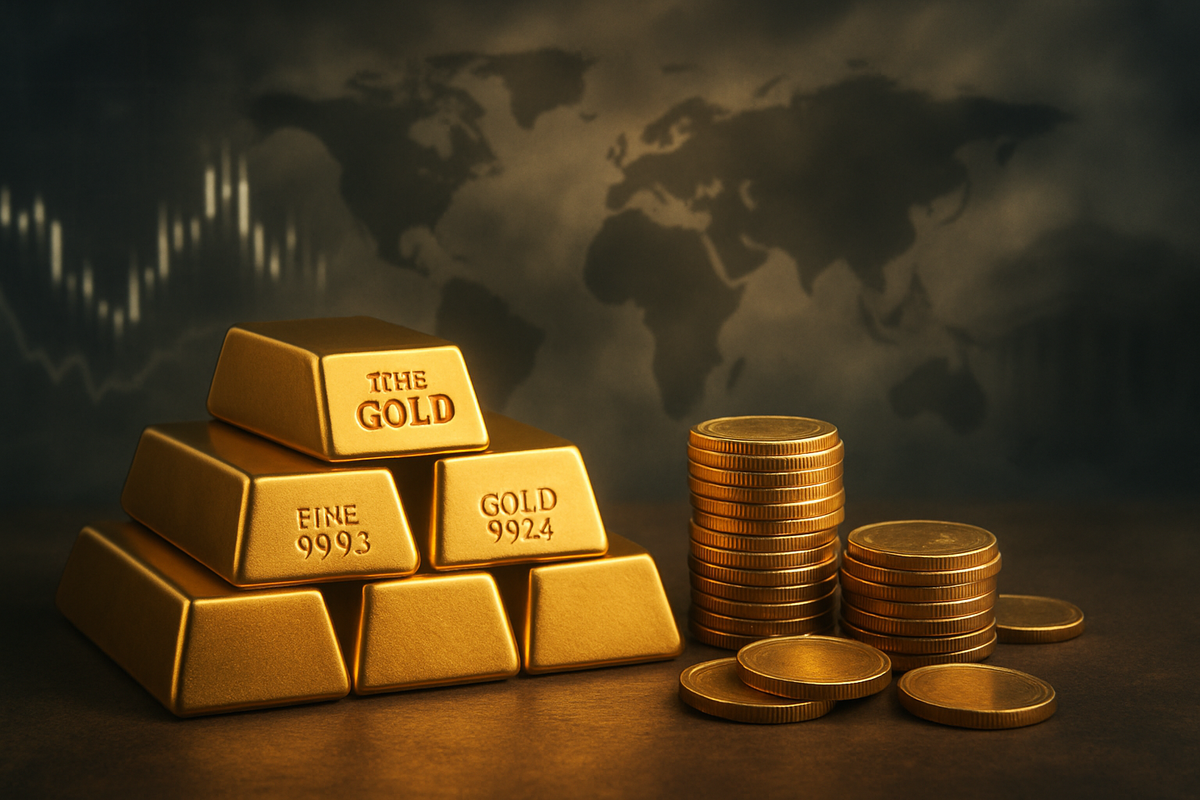
As the United States federal government grapples with its eleventh shutdown in modern history, gold prices have surged for an unprecedented seventh consecutive week, shattering previous records and solidifying its role as the premier safe-haven asset for investors worldwide. The precious metal's ascent above the $3,900 per ounce mark on October 3, 2025, underscores a profound global market anxiety, driven by domestic political gridlock in the US and broader concerns over economic stability. This rally highlights a significant shift in investor sentiment, as capital flows from riskier assets into gold, particularly from discerning investors in Asia and Europe seeking refuge from the prevailing uncertainty.
The ongoing fiscal impasse, which commenced at 12:01 a.m. EDT on October 1, 2025, marks the fourth such shutdown under President Donald Trump's administration. It stems from a deep partisan divide over federal spending levels, foreign aid rescissions, and health insurance subsidies, with negotiations between Republican and Democratic lawmakers collapsing without resolution. This political paralysis has not only furloughed approximately 800,000 federal employees and forced another 700,000 to work without pay but has also cast a long shadow over the global financial markets, with estimated economic costs running into billions of dollars weekly and threatening to reduce GDP growth.
Unprecedented Rally: Gold's Ascent Amidst Political Turmoil
Gold's recent performance has been nothing short of spectacular. The precious metal shattered previous records, climbing above $3,890 per ounce in early October 2025, and even touching $3,900 per ounce in some reports. This surge contributed to an impressive 12% increase from $3,476 on September 1 to $3,895 a month later. Year-to-date, gold has seen a remarkable 48% increase, building on a 31% rise until June 2025. While international spot gold prices saw a slight decline of approximately 0.75% on October 3, 2025, settling at $3,842.1, it remains firmly entrenched near historic highs.
The timeline leading to this moment has been characterized by escalating political tensions and growing economic concerns. The failure of Congress to pass appropriations legislation for the 2026 fiscal year, which began on October 1, 2025, directly triggered the shutdown. Subsequent attempts in the Senate on October 3, 2025, to advance competing proposals to end the funding lapse also failed, indicating a prolonged period of uncertainty. Key players involved include the US Congress, President Donald Trump, and global investors who are reacting to the lack of political consensus. Initial market reactions have been swift and decisive, with a clear flight to safety. The delay of crucial federal data releases, such as the September Jobs Report, due to the shutdown, has further exacerbated market uncertainty, intensifying the appeal of gold.
Market analysts attribute this unprecedented rally to a "perfect storm" of factors. Beyond the political gridlock, monetary policy expectations—particularly the high probability of a Federal Reserve rate cut—inflationary concerns, and simmering global geopolitical tensions are all contributing to gold's allure. The diminishing confidence in the US dollar as a safe haven, coupled with gold hitting an all-time high in real terms (surpassing previous inflation-adjusted peaks), indicates a deeper shift in investor psychology.
Winners and Losers: Corporate Fortunes in a Golden Era
The sustained rally in gold prices presents a clear dichotomy of winners and losers within the financial markets. For companies directly involved in gold mining and related investment vehicles, this period is proving to be immensely profitable.
Winners:
- Gold Mining Companies: Major gold producers like Barrick Gold (NYSE: GOLD) and Newmont (NYSE: NEM) are poised to benefit significantly from elevated gold prices. Higher prices translate directly into increased revenues and improved profit margins, assuming production costs remain stable. Smaller exploration and development companies in the gold sector may also see increased investor interest and access to capital.
- Gold-Backed Exchange-Traded Funds (ETFs): Funds such as SPDR Gold Shares (NYSE Arca: GLD), which directly track the price of gold, are experiencing substantial inflows. Investors seeking exposure to gold without direct physical ownership or futures trading are flocking to these accessible investment vehicles, boosting their asset under management and potentially their stock prices for the managing firms.
- Precious Metals Dealers and Refiners: Companies involved in the physical trading, refining, and storage of gold will see increased demand and activity.
- Investment Funds with Gold Exposure: Hedge funds and mutual funds that have strategically allocated a portion of their portfolios to gold or gold-related assets are likely outperforming broader market indices, attracting more capital from risk-averse investors.
Potential Losers (or those facing headwinds):
- Companies reliant on Government Contracts: Businesses that derive a significant portion of their revenue from federal contracts face payment delays or cancellations due to the shutdown, impacting their cash flow and operational stability.
- Sectors Sensitive to Economic Uncertainty: Industries such as retail, hospitality, and certain manufacturing sectors, which are highly sensitive to consumer confidence and economic stability, may experience reduced demand and investment as the shutdown's economic impact ripples through the economy.
- Financial Institutions (indirectly): While some investment banks might benefit from increased trading volatility, a prolonged shutdown could erode overall economic stability, leading to higher credit risks, reduced lending activity, and a general slowdown in financial markets.
- Companies with High US Dollar Exposure: As the US dollar's safe-haven appeal potentially wanes in comparison to gold, companies with significant foreign currency exposure might face adverse impacts from currency fluctuations, although gold's rally is currently transcending a weakening dollar.
Broader Implications: A Shift in Global Financial Dynamics
Gold's sustained rally and its robust safe-haven performance during the current US government shutdown are indicative of broader, more profound shifts in global financial dynamics. This event is not merely a reaction to a temporary political hiccup; it reflects a deepening concern over structural economic stability and the efficacy of traditional governance.
The current trend fits squarely into a broader industry shift towards tangible assets and away from traditional financial instruments, especially during periods of elevated geopolitical tensions and inflationary pressures. Investors are increasingly prioritizing wealth preservation over growth, leading to a re-evaluation of portfolio allocations. The expectation of potential Federal Reserve rate cuts further bolsters gold's appeal, as lower interest rates reduce the opportunity cost of holding a non-yielding asset. This scenario creates a fertile ground for gold to thrive, as it becomes a more attractive store of value compared to bonds or cash that offer diminished returns.
The ripple effects of this gold surge are multifaceted. It could put pressure on other commodity markets, as capital flows into precious metals might divert from industrial commodities. In currency markets, the US dollar's traditional role as the ultimate safe haven is being challenged, particularly for international investors who are increasingly looking to gold as a more reliable alternative during periods of US fiscal instability. This could lead to greater volatility in foreign exchange markets. Historically, while past government shutdowns (e.g., 2013, 2018, 2018-2019) have sometimes provided a limited boost to gold, the current situation shows a much more pronounced positive correlation, signaling a heightened level of investor anxiety and deeper concerns about global economic resilience and the interplay between fiscal and monetary policy. This suggests that the market views this shutdown as more than just a temporary inconvenience, but rather a symptom of deeper systemic issues.
The Road Ahead: Navigating Uncertainty
Looking ahead, the trajectory of gold prices will largely hinge on the resolution of the US government shutdown and the broader economic outlook. In the short term, if the political gridlock persists, gold is likely to maintain its upward momentum, possibly pushing even higher as uncertainty continues to dominate market sentiment. Investors will closely monitor any signs of progress in congressional negotiations and statements from the Federal Reserve regarding monetary policy. A prolonged shutdown could lead to increased market volatility across all asset classes, further cementing gold's role as a defensive play.
In the long term, gold's performance will be influenced by persistent inflation concerns, global geopolitical stability, and the overall health of the global economy. Should central banks, including the Federal Reserve, embark on a path of sustained rate cuts, the environment would remain favorable for gold. Conversely, a swift and decisive resolution to the shutdown, coupled with signs of robust economic recovery, could temper gold's rally, as risk appetite returns to the market.
Market opportunities will primarily emerge in gold-related assets, including physical gold, gold ETFs, and shares of well-managed gold mining companies. Investors may also explore diversified portfolios that incorporate other safe-haven assets or inflation hedges. However, challenges will abound for sectors and companies highly sensitive to economic slowdowns or dependent on government stability. Potential strategic pivots for businesses might include diversifying revenue streams, reducing reliance on government contracts, and strengthening balance sheets to weather prolonged periods of uncertainty. Scenarios range from a rapid resolution leading to a market rebound, to a protracted shutdown causing significant economic damage and sustained gold strength, or even a global recession further propelling gold to new heights.
Wrap-Up: A Golden Indicator of Market Distress
Gold's seven-week rally, culminating in record-breaking prices amidst an ongoing US government shutdown, serves as a powerful indicator of significant market distress and a widespread flight to safety. The precious metal's unprecedented ascent underscores a global lack of confidence in traditional financial stability, driven by political paralysis in the world's largest economy and pervasive concerns over inflation and broader economic resilience.
Moving forward, the market will remain highly sensitive to political developments in Washington D.C. A swift and amicable resolution to the government shutdown could alleviate some immediate pressure, potentially leading to a consolidation in gold prices. However, the underlying factors that fueled this rally—monetary policy expectations, inflation fears, and geopolitical tensions—are unlikely to dissipate quickly. Gold's enhanced safe-haven status is a testament to investors' deep-seated anxieties and their preference for tangible assets during periods of profound uncertainty.
The lasting impact of this event may be a permanent re-evaluation of investment strategies, with a greater emphasis on diversification and hedging against systemic risks. Investors should closely watch for any progress in congressional negotiations, forthcoming economic data (once released), and statements from major central banks. The gold market will continue to be a crucial barometer of global confidence, reflecting the ongoing interplay between fiscal policy, monetary decisions, and geopolitical stability in the months to come.
This content is intended for informational purposes only and is not financial advice





